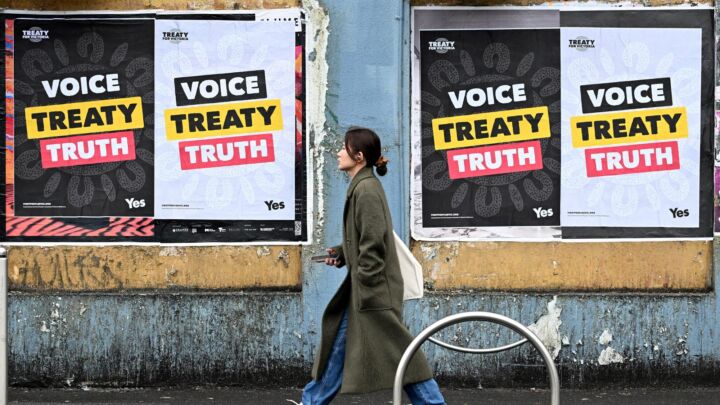Turning the Holocaust into a fable
The Boy In the Striped Pyjamas is just the latest example of the Final Solution being reduced to a trite morality tale.

The Boy In the Striped Pyjamas (view the trailer below) has been accused of ‘Disneyfying the Final Solution’. Watching the film, it is not hard to see why.
For one, it is a childhood tale produced and distributed by the Disney subsidiary, Miramax. And like the Dreamfactory’s animated features, The Boy In the Striped Pyjamas, which is based on a children’s book, is a morality tale and a film which both kids and adults can enjoy.
The film tells the story of two eight-year-old boys who are at either side of Auschwitz’s fence. The one wearing the ‘striped pyjamas’ – Shmuel – is a Jew destined for the gas chambers. The other boy, Bruno, is the son of the camp’s newly-appointed commandant. The two boys strike up an unlikely friendship.
Even after weeks of hanging out with Shmuel by the electric barbed wire fence, playing checkers and eating sandwiches and cakes – which Shmuel wolfs down – Bruno still doesn’t realise that the pyjamas are, in fact, uniforms for death camp inmates. He still believes Shmuel lives on some kind of farm for Jews with low ambitions. For example, he observes that one of the ‘farmers’, Pavel, who often comes over to do grunt work at Bruno’s house which is near the camp, ‘used to be a doctor, but now he just peels potatoes’.
Bruno doesn’t get what that smelly smoke coming out of the chimneys is all about or why his dad’s subordinate beat Pavel to death just because he spilled some red wine while serving dinner. He never questions why soldiers with barking Alsatians shout orders at the emaciated ‘farmers’ as they build a wooden hut. And, strangely, Shmuel is rather chubby and manages to get a lot of ‘alone-time’ by the fence which, in reality, would have been closely monitored by SS soldiers in watchtowers.
The question of whether or not the story line and the film’s details are plausible might seem petty. After all, the full title of the book it is based on is The Boy In the Striped Pyjamas: A Fable, and so the moral message takes precedence over realism.
In depicting the Holocaust through the eyes of innocent children, who are seen as untainted by the evil that apparently lurks in all grown men, John Boyne, the author of the book, and Mark Herman, the film’s director, can avoid addressing the historical as well as moral complexity of the Holocaust. They simply urge us to feel the pain of innocent children growing up during the Second World War. The injustice suffered by millions of Jews and others appears inexplicable.
The John Betjeman quote which opens the film is telling: ‘Childhood is measured out by sounds and smells and sights, before the dark hour of reason grows.’
But Herman should take heed of Paul Bailey’s injunction, in his introduction to Primo Levi’s memoirs If This Is a Man, which recounts in painstaking detail the horrors of Auschwitz: ‘I hope [Levi’s books] find their way into the hands of the practitioners of the new sentimentality – those who try to persuade us, with increasing shrillness, that Man is vile: the artists who use the terrible fact of the camps for emotional and aesthetic effect, and the critics who compare their grimmer brand of kitsch to King Lear and the paintings of Goya’s last years.’ (1)
The Boy In the Striped Pyjamas is based on a children’s novel and it presents a child’s eye view of the Holocaust, so perhaps a bit of simplification is understandable? If it can serve as a light introduction for children to the horrors of the Holocaust and spark in them an interest to find out more, doesn’t that justify a bit of factual laxness?
In fact, the film is not exclusively aimed at young people. There were no children in the cinema where I saw it and Herman himself has said that it is only a family film in the sense that ‘parents can, and probably should, take their kids. I don’t think it’s specifically aimed at kids at all’ (2).
And, besides, as Linda Grant, writing in the Guardian, recognises, there is a danger here: ‘When you make films about the Final Solution for children there’s not much you can say other than to introduce the historical events in a palatable way, and to make a general lesson about being nice to other people.’ (3)
Grant has a point, but her critique misses the mark. Not only is it possible to teach children about the Holocaust without presenting it as a fable, but The Boy In the Striped Pyjamas does contain several ‘unpalatable’ moments. For example, Shmuel’s and Bruno’s tragic fate reflect those of most concentration camp inmates.
And while the film, as Grant says, indeed ‘sentimentalises the subject and draws the mind away from the moral complexity of the many questions the Final Solution raises’, when it comes to ‘Disneyfying the Holocaust’, as she puts it, The Boy In the Striped Pyjamas is in no way original.
The film is simply the latest manifestation of how the Holocaust has been turned into a simplistic fable. It has become a moral absolute for our relativistic times – the one tragedy that we can all agree must never happen again. To this effect, the Holocaust is now evoked in debates on everything from the conflict in Darfur to animal rights and schoolyard bullying.
As the film’s producer, David Heyman, says, while The Boy In the Striped Pyjamas is ‘a Holocaust story set in 1940s Germany, for me it is timeless’. He then cites ‘such contemporary horrors as Rwanda, Darfur and Somalia’ (4). In conceiving of the Holocaust as a historical horror story that keeps being repeated in different forms, we lose sight of the particularities of each of those events and this reduces our ability to properly understand any of them.
Many well-intentioned initiatives to maintain the memory of the Holocaust end up relativising it and belittling the experiences of those who were persecuted, enslaved, gassed to death or forced to flee their home countries under the threat of extermination in Nazi concentration camps.
Consider the Holocaust Memorial Day Trust in Britain for example. Each year, the trust comes up with a new theme for the memorial day, and these are conveyed to the public through simplistic slogans. This year’s theme was ‘Imagine, remember, reflect, react’, while 2007’s key message was ‘same – but different’. The idea that the millions who perished in Europe in the 1930s and 40s were killed ‘just because they were ‘different”’, as the trust put it, means reducing the anti-Semitism that gave rise to the Holocaust to just an extreme form of social exclusion.
The New Labour government initiated Holocaust Memorial Day in 2001 and the trust’s literature is littered with New Labourite buzzwords such as inclusion, crossing cultural barriers, celebrating difference, engaging disaffected youth, building respect and addressing bullying. Taking action on these issues has nothing to do with remembering the Holocaust, and everything to do with the government’s crass community cohesion agenda.
Yes, there are lessons to be learnt from the Holocaust and we should not forget that six million Jews and others were systematically slaughtered at the hands of the Nazis. But the reduction of the Holocaust to a political prop, to a morality lesson for the masses and a mere symbol of evil only serves to diminish the memory of its victims.
While The Boy In the Striped Pyjamas takes a childish approach to the Holocaust, it seems most initiatives today to spread awareness of the subject treat us all as children who are incapable of understanding the political and moral complexity of this great atrocity.
As for Grant, she only doubts the validity of making a Holocaust film for children because she believes that not even adults can be expected to understand it. As she puts it: ‘We are ourselves too childlike to understand much of the great opaque experience of the Final Solution, with only occasional windows breaking through the stone walls of history. How can we expect children to understand what we do not?’ (5)
The mainstreaming of this demeaning attitude poses a greater threat to historical awareness and to the memory of the Holocaust than any single children’s film could ever do.
Nathalie Rothschild is commissioning editor of spiked. She is speaking in the session Immigration: the more the scarier?, and chairing the session Candid camera at the Battle of Ideas festival at the Royal College of Art, London on 1&2 November.
Read on:
spiked-issue: Film
(1) See Paul Bailey’s introduction to Primo Levi’s If This Is a Man and The Truce, Abacus, 1987
(2) Disney’s ‘The Boy in the Striped Pyjamas’ – The stuff of nightmares, The Scotsman, 11 September 2008
(3) How can they understand?, Guardian, 29 August, 2008
(4) The Boy In The Striped Pyjamas, Jewish Chronicle, 12 September
(5) How can they understand?, Guardian, 29 August, 2008
To enquire about republishing spiked’s content, a right to reply or to request a correction, please contact the managing editor, Viv Regan.









Comments
Want to join the conversation?
Only spiked supporters and patrons, who donate regularly to us, can comment on our articles.